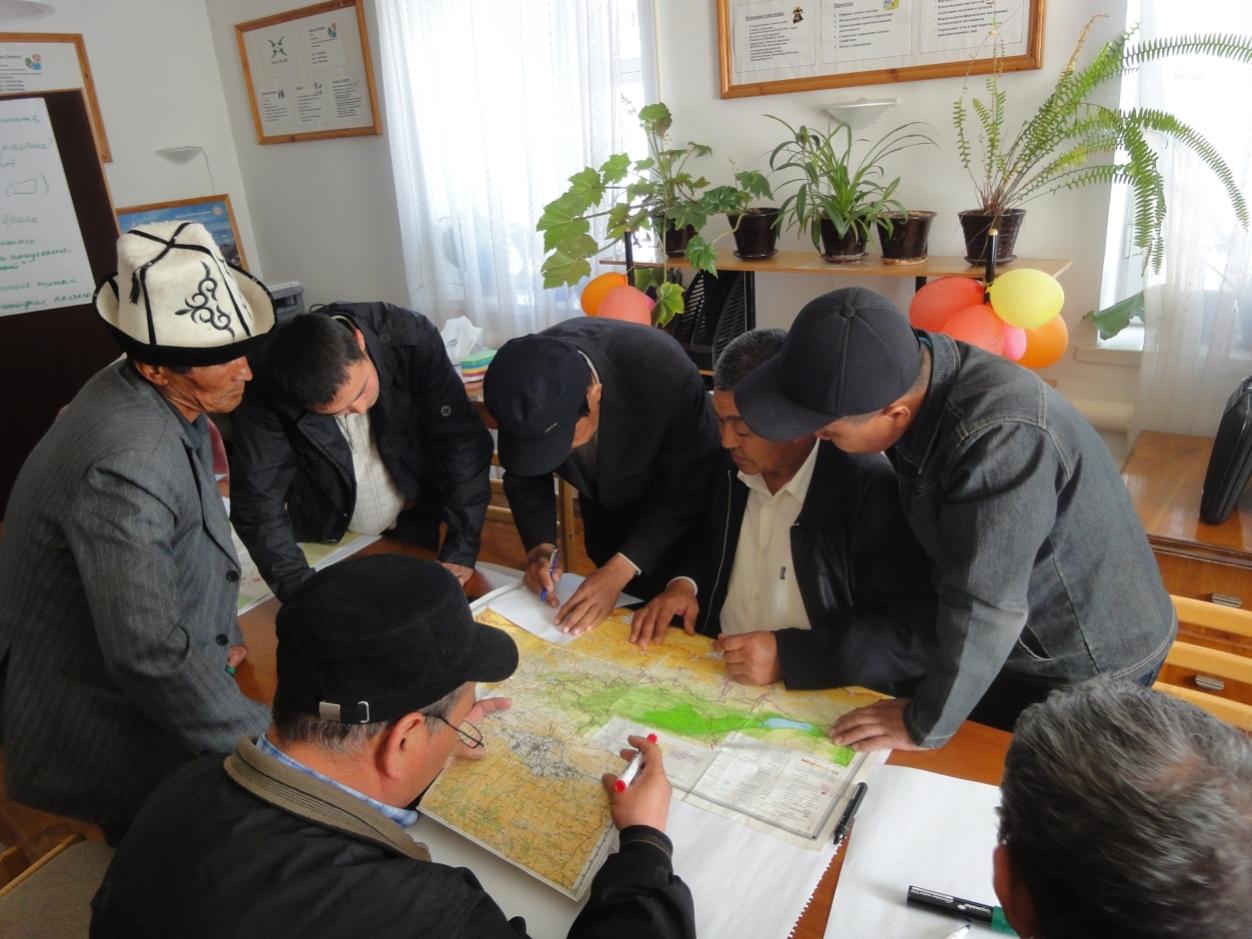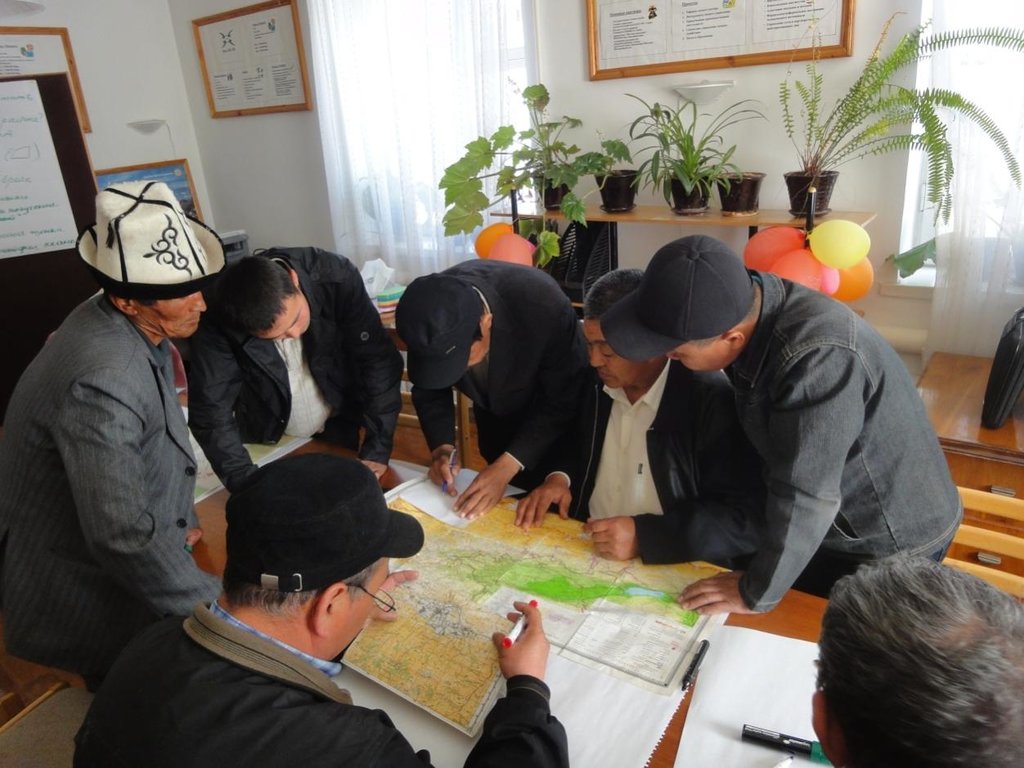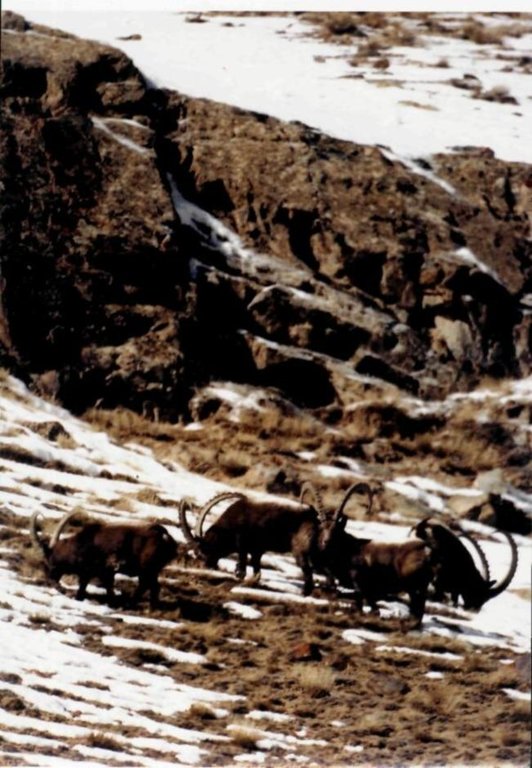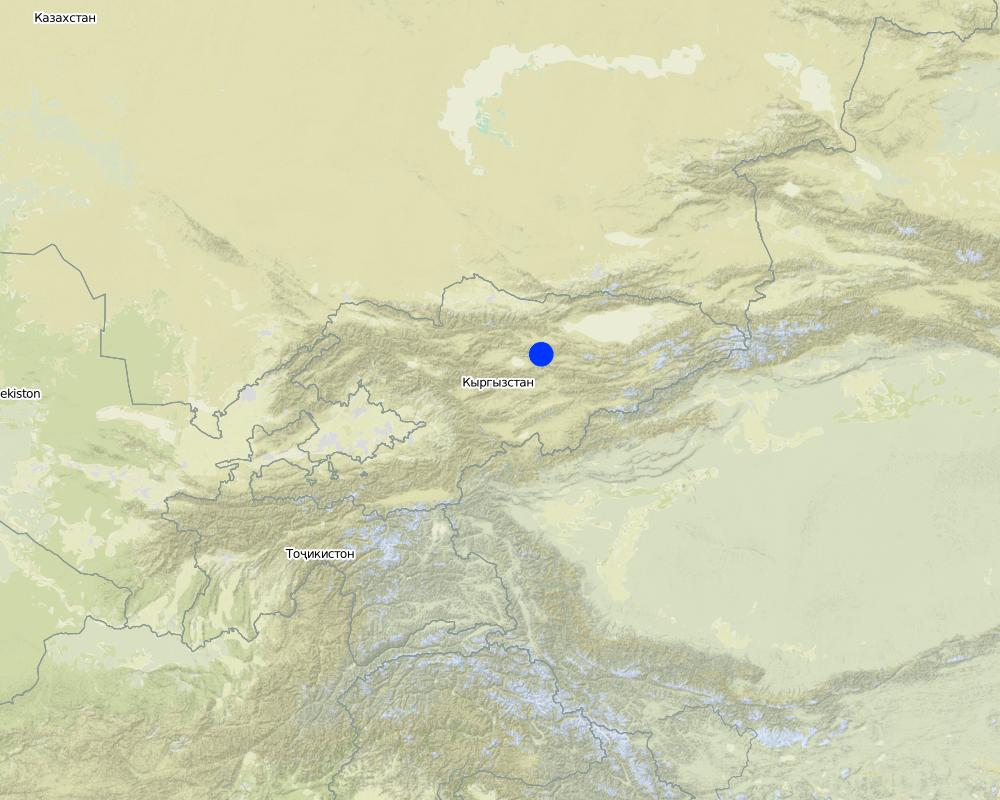Joint Wildlife Management in the mountain ecosystem of the Naryn region in Kyrgyzstan [ប្រទេសកៀហ្ស៊ីស៊ីស្ថាន]
- ការបង្កើត៖
- បច្ចុប្បន្នភាព
- អ្នកចងក្រង៖ Nazgul Esengulova
- អ្នកកែសម្រួល៖ –
- អ្នកត្រួតពិនិត្យ Alexandra Gavilano
Нарын областында тоолуу экосистемаларынын табигый анчылык ресурстарын жергиликтуу жамааттардын негизинде колдонуу
approaches_2582 - ប្រទេសកៀហ្ស៊ីស៊ីស្ថាន
ពិនិត្យមើលគ្រប់ផ្នែក
ពង្រីកមើលទាំងអស់ បង្រួមទាំងអស់1. ព័ត៌មានទូទៅ
1.3 លក្ខខណ្ឌទាក់ទងទៅនឹងការប្រើប្រាស់ទិន្នន័យដែលបានចងក្រងតាមរយៈវ៉ូខេត
តើពេលណាដែលទិន្នន័យបានចងក្រង (នៅទីវាល)?
11/05/2012
អ្នកចងក្រង និង(បុគ្គលសំខាន់ៗ)យល់ព្រមទទួលយកនូវលក្ខខណ្ឌនានាទាក់ទងទៅនឹងការប្រើប្រាស់ទិន្នន័យដែលបានចងក្រងតាមរយៈ វ៉ូខេត:
បាទ/ចា៎
2. ការពណ៌នាអំពីវិធីសាស្ត្រផ្សព្វផ្សាយ SLM
2.1 ពណ៌នាសង្ខេបខ្លីពីវិធីសាស្ត្រផ្សព្វផ្សាយ
Joint Wildlife Management based on economic empowerment and assigning hunting (wildlife) grounds to the Association of local hunters and providing her with user rights for game resources leads to a sustainable use of natural resources and biodiversity and wildlife conservation (in the frame of CACILM).
2.2 ពណ៌នាលម្អិតពិវិធីសាស្ត្រផ្សព្វផ្សាយ
ពណ៌នាលម្អិតពិវិធីសាស្ត្រផ្សព្វផ្សាយ:
Aims / objectives: Wildlife in Kyrgyzstan, especially mountain ungulates, is threatened because these resources can be easily accessed due to an inadequate state supervision and regulation as well as due to lack of knowledge among the local population and mechanism for integrated land use (considering different coordinated types of resource use) and resource conservation. Decrease in the natural habitat (caused by the expansion of pasture and arable land) and illegal hunting lead to a decrease in wildlife populations. In Kyrgyzstan, the fauna is exclusively owned by the state. User rights for wildlife are separated from land use ones. The approach aims at the conservation and sustainable use of wildlife based on providing representatives of the local community, organized in an Association of local hunters (ALH), with legal user rights for wildlife resources.
Methods: (1) supporting local hunters in organizing an Association of local hunters (ALH) with the help of facilitators; (2) transferring wildlife management functions from the Wildlife Department to the ALH based on assigning hunting grounds to them and providing them with user rights according to jointly developed management plans; (3) building trust in partnership relations between the ALH and the Wildlife Department of State Agency for Environmental Protection and Forestry (SAEPF) based on joint registration and monitoring and determination of the resource status (see Annex 3); (4) capacity building of the ALH with the help of independent experts and advising activities provided by the Wildlife Department; (5) developing an atmosphere of trust by establishing links between the Wildlife Department, local hunters (ALH), the local community (Aiylokmotu) and rural organizations (Pasture User Association, PUA) based on joint planning and information sharing.
Stages of implementation: (1) setting up groups of well-trained (sensitive) facilitators and training them on the principles of facilitation, conflict management and sustainable management of natural resources; (2) identifying reliable active hunters with the help of facilitators and managers by interviewing neutral people; (3) organizing a meeting at the field level to analyze the situation and identify interests in establishing of the ALH; (4) raising awareness of local hunters on wildlife resources, existing problems and possible solutions offered by sustainable management; (5) establishing an ALH in the pilot area as a legal entity; (6) assigning areas to the ALH and advising activities on methods for wildlife management provided by the Wildlife Department and the specialized NGO 'Ak-Terek'; (7) organizing expeditions with specialists from the Wildlife Department to register and monitor the resource status; (8) developing a management plan with the support of experts from the Wildlife Department and independent experts, plan approval and implementation.
2.3 រូបភាពនៃវិធីសាស្ត្រផ្សព្វផ្សាយ
2.5 ប្រទេស/តំបន់/ទីតាំងកន្លែង ដែលវិធីសាស្ត្រផ្សព្វផ្សាយត្រូវបានអនុវត្តន៍
ប្រទេស:
ប្រទេសកៀហ្ស៊ីស៊ីស្ថាន
តំបន់/រដ្ឋ/ខេត្ត:
Kyrgyzstan, Naryn oblast
បញ្ជាក់បន្ថែមពីលក្ខណៈនៃទីតាំង:
Kochkor district, Toloksky Aiylokmotu (villages Tolok and Kok-Jar)
Map
×2.6 កាលបរិច្ឆេទនៃការចាប់ផ្តើម និងបញ្ចប់នៃវិធីសាស្រ្តផ្សព្វផ្សាយនេះ
សូមបញ្ជាក់ឆ្នាំដែលបានបង្កើតឡើង:
2010
ឆ្នាំបញ្ចប់ (ប្រសិនបើវិធីសាស្ត្រផ្សព្វផ្សាយត្រូវបានឈប់ប្រើប្រាស់):
2014
2.7 ប្រភេទនៃវិធីសាស្ត្រផ្សព្វផ្សាយ
- ផ្អែកលើគម្រោង/កម្មវិធី
2.8 គោលបំណង/ទិសដៅសំខាន់នៃវិធីសាស្ត្រផ្សព្វផ្សាយ
The Approach focused mainly on other activities than SLM (Transferring responsibilities of wildlife management to the local population, assigning hunting grounds to the Association of local Hunters and providing her with legal user rights for game resources, sustainable management of wildlife and joint planning)
The approach aims at conservation and sustainable use of wildlife based on economic empowerment and transfer of legal use rights for wildlife resources to representatives of the local community, organized in the Association of local hunters according to jointly developed management plans.
The SLM Approach addressed the following problems: Decrease in wildlife populations due to an unregulated unsustainable use of resources by the local population and due to lack of participatory mechanisms for the population to manage these resources, inadequate state regulation and supervision, aggravated by a conflict of interest among users over other natural resources with different intentions (pasture, forest, mineral resources, tourism).
2.9 លក្ខខណ្ឌអនុញ្ញាត ឬរារាំងការអនុវត្តន៍បច្ចេកទេសដែលស្ថិតនៅក្រោមវិធីសាស្រ្តផ្សព្វផ្សាយ
សង្គម/វប្បធម៌/ និងតម្លៃនៃសាសនា
- រារាំង
Hunting is basically illegal. Local hunters do not trust the new approach of wildlife management and have no capacity for self-organization and no experience of joint decision making.
Treatment through the SLM Approach: Providing necessary information to the local population by holding meetings and seminars with representatives of the Wildlife Department. Trainings on capacity building for self-organization.
ភាពអាចរកបាននៃធនធានហិរញ្ញវត្ថុ និងសេវាកម្ម
- រារាំង
There is a need for initial investment to get the ALH started and deferred revenues are expected. The ALH is not expected to extract big financial revenues from wildlife management and wildlife use.
Treatment through the SLM Approach: Explanation of financial expectations (exclusive right of first access to game resources and authority of access right distribution, patriotism)
បរិបទនៃស្ថាប័ន
- រារាំង
There is a lack of joint organizations at the field level which manage wildlife resources sustainably.
Treatment through the SLM Approach: Establishing an Association of local hunters to manage wildlife resources sustainably
ក្របខណ្ឌច្បាប់ (សិទ្ធិកាន់កាប់ដីធ្លី កម្មសិទ្ធីប្រើប្រាស់ដីនិងទឹក)
- រារាំង
There is a lack of policy promoting Joint Wildlife Management
Treatment through the SLM Approach: Order of the Wildlife Department, Concept of Reform for wildlife sector prohibiting state agencies to manage wildlife economically, promoting the assignment of wildlife areas to the ALH
The existing land ownership, land use rights / water rights greatly hindered the approach implementation Existing legislation does not comply with the principles of sustainable use and wildlife management and does not promote Joint Wildlife Management. There is a lack of regulation and integration of land users.
ចំណេះដឹងស្តីពី SLM និងការទទួលបានការគាំទ្រផ្នែកបច្ចេកទេស
- រារាំង
The local population has no necessary capacities (environmental awareness, knowledge of sustainable wildlife management).
Treatment through the SLM Approach: Trainings
3. ការចូលរួម និងតួនាទីរបស់ភាគីពាក់ព័ន្ធ
3.2 ការចូលរួមរបស់អ្នកប្រើប្រាស់ដីក្នុងតំបន់/ សហគមន៍ក្នុងតំបន់ក្នុងដំណាក់កាលផ្សេងគ្នានៃវិធីសាស្រ្តផ្សព្វផ្សាយ
| ការចូលរួមរបស់អ្នកប្រើប្រាស់ដីក្នុងតំបន់/សហគមន៍ក្នុងតំបន់ | សូមបញ្ជាក់នរណាត្រូវបានចូលរួម ព្រមទាំងពណ៌នាសកម្មភាពទាំងនោះ | |
|---|---|---|
| ការចាប់ផ្តើម/ការលើកទឹកចិត្ត | អន្តរកម្ម | Consulting with the Wildlife Department |
| ការរៀបចំផែនការ | អន្តរកម្ម | Participation at discussing the approach design and determining the form and specifics of self-organization |
| ការអនុវត្តន៍ | អន្តរកម្ម | Local hunters implement the approach through their representatives in the ALH |
| ការត្រួតពិនិត្យ និងវាយតម្លៃ | អន្តរកម្ម | Monitoring and evaluation are conducted on base of questionnaires and interviews with key actors supported by the Wildlife Department and GIZ Project and on base of annual progress assessment in reports prepared for the Wildlife Department (increase in wildlife population, reducing conflicts among resource users). |
| Research | គ្មាន |
3.3 គំនូសបំព្រួញ (ប្រសិនបើមាន)
ការពណ៌នា:
The approach has been implemented by the GIZ project 'Sustainable management of the mountain ungulate species' under the Regional Program on Sustainable Use of Natural Resources in Central Asia which initiated and implemented establishment of the ALH in conjunction with the Wildlife Department and the NGO 'Ak-Terek'. The Wildlife Department has developed new methods for monitoring and determining wildlife quotas. The NGO 'Ak-Terek' promotes and facilitates self-organization of hunters in the ALH, mitigate possible conflicts arising in the integrated land use. Local hunters are organized into the ALH, defining her structure and principles of organization (legal status, functions, membership), as well as monitoring and developing management plan, etc. The Wildlife Department confirms the legal assignment of wildlife areas to the ALH and provides advice to them on game management.
អ្នកនិពន្ធ:
Nazgul Esengulova (720001, Logvinenko St., 26а, Bishkek, Kyrgyzstan )
3.4 ការសម្រេចចិត្តលើការជ្រើសរើសបច្ចេកទេស SLM
តើការសម្រេចចិត្តក្នុងការជ្រើសរើសបច្ចេកទេស(ច្រើន)ត្រូវបានធ្វើឡើងយ៉ាងដូចម្តេច?
- Experts from the Wildlife Department
ចូរពន្យល់:
In a seminar involving the local population and project experts and experts from the NGO 'Ak-Terek' as facilitators in order to explain the principles of wildlife management.
Decisions on the method of implementing the SLM Technology were made by mainly by land users supported by SLM specialists. Decisions were made by the village population supported by WLD experts.
In the meeting of key hunters, shepherds and other interested residents of the village with the project staff and the Foundation 'Ak-Terek', there was determined a form of local self-organization of wildlife users.
4. ជំនួយបច្ចេកទេស ការកសាងសមត្ថភាព និងការគ្រប់គ្រងចំណេះដឹង
4.1 ការកសាងសមត្ថភាព/ បណ្តុះបណ្តាល
តើវគ្គបណ្តុះបណ្តាលបានផ្តល់ឱ្យអ្នកប្រើប្រាស់ដី/អ្នកពាក់ព័ន្ធផ្សេងៗទៀតដែរឬទេ?
បាទ/ចា៎
សូមបញ្ជាក់តើអ្នកណាត្រូវបានបណ្តុះបណ្តាល:
- អ្នកប្រើប្រាស់ដី
- Wildlife Department
ប្រសិនទាក់ទង សូមបញ្ជាក់ ភេទ អាយុ ស្ថានភាពគ្រួសារ ជនជាតិដើមភាគតិច។ល។:
Mainly males at age 40-50
ទម្រង់នៃការបណ្តុះបណ្តាល:
- អនុវត្តន៍ជាមួយការងារ
- ពីកសិករទីកសិករ
- ការប្រជុំជាសាធារណៈ
ទម្រង់នៃការបណ្តុះបណ្តាល:
- 2 day seminars on the spot
ប្រធានបទបណ្តុះបណ្តាល:
1. Raising awareness of actual problems and possible solutions; joint mapping of resources and discussion of scenarios for development of hunting grounds;
2. Principles of sustainable wildlife use;
3. Methods for monitoring and registering the number of wild animals;
4. Planning economic activities of game management for an assigned area;
5. Professional ethics of game users;
6. Programs for employees of environmental, law enforcement and customs authorities.
4.2 សេវាផ្តល់ប្រឹក្សាយោបល់
តើអ្នកប្រើប្រាស់ដីបានទទួលនូវសេវាផ្តល់ប្រឹក្សាដែរ ឬទេ?
បាទ/ចា៎
ពណ៌នា/ពន្យល់:
Name of method used for advisory service: situation analysis; Key elements: on-site visit, group consultation during workshop, preparation of resource map
Advisory service is quite adequate to ensure the continuation of land conservation activities; Department with its local staff and the NGO 'Ak-Terek' are capable to continue providing advisory services after the project finishes.
4.3 ការពង្រឹងសមត្ថភាពស្ថាប័ន (ការអភិរឌ្ឍន៍អង្គភាព)
តើស្ថាប័នទាំងអស់ត្រូវបានបង្កើតឡើង ឬពង្រឹងសមត្ថភាពតាមរយៈវិធីសាស្ត្រផ្សព្វផ្សាយដែរ ឬទេ?
- ទេ
4.4 ការត្រួតពិនិត្យ និងវាយតម្លៃ
តើការត្រួតពិនិត្យ និងវាយតម្លៃគឺជាផ្នែកមួយនៃវិធីសាស្ត្រដែរឬទេ?
បាទ/ចា៎
មតិយោបល់:
bio-physical aspects were regular monitored by project staff, land users through observations; indicators: expeditions, field researches, surveys
bio-physical aspects were regular monitored by project staff, land users through measurements; indicators: number of wild animals
economic / production aspects were regular monitored by project staff through measurements; indicators: benefit from selling hunting tours and ecotourism
no. of land users involved aspects were regular monitored by project staff through measurements; indicators: Number of hunters and associations
management of Approach aspects were regular monitored by project staff, government through observations; indicators: annual planning, monitoring of achievement and difficulties, adaptation of the approach if necessary
There were no changes in the Approach as a result of monitoring and evaluation: None
There were no changes in the Technology as a result of monitoring and evaluation: None
5. ថវិកា និងសម្ភារៈឧបត្ថម្ភពីខាងក្រៅ
5.1 ថវិកាប្រចាំឆ្នាំសម្រាប់ផ្សព្វផ្សាយ SLM
ប្រសិនបើចំនួនពិតប្រាកដនៃថវិកាប្រចាំឆ្នាំមិនត្រូវបានដឹងច្បាស់ សូមប្រាប់ពីចន្លោះនៃថវិកានោះ:
- 10,000-100,000
មតិយោបល់ (ឧ. ប្រភពសំខាន់នៃមូលនិធិ/ម្ចាស់ជំនួយចំបង):
Approach costs were met by the following donors: international (GIZ, via “Sustainable use of the mountain ungulate species in Kyrgyzstan” ): 95.0%; government (Wildlife Department of SAEPF): 5.0%; national non-government (PF “Ak-Terek” ); local community / land user(s) (local resource users )
5.3 សូមបញ្ជាក់ពីធាតុចូលត្រូវបានផ្តល់បដិភាគ (រួមទាំងកម្លាំងពលកម្ម)
មតិយោបល់:
Voluntary participation in monitoring and registering as well as analyzing wildlife areas for the further assignment of hunting grounds to hunters
5.4 ឥណទាន
តើឥណទានដែលបានផ្តល់នៅក្រោមវិធីសាស្ត្រផ្សព្វផ្សាយសម្រាប់សកម្មភាព SLM នេះយ៉ាងដូចម្តេច?
ទេ
6. ការវិភាគរកផលប៉ះពាល់ និងសេចក្តីសន្និដ្ឋាន
6.1 ផលប៉ះពាល់នៃវិធីសាស្ត្រផ្សព្វផ្សាយ
តើវិធីសាស្ត្រផ្សព្វផ្សាយជួយអ្នកប្រើប្រាស់ដីដើម្បីអនុវត្តន៍ និងថែទាំបច្ចេកទេស SLM?
- ទេ
- បាទ/ច៎ា បន្តិចបន្តួច
- បាទ/ច៎ា ជាមធ្យម
- បាទ/ច៎ា បានខ្លាំង
With establishing the Association of local hunters and involving the latter into wildlife management, stabilization and even an increasing tendency of wildlife populations according to ecosystem's carrying capacity have been made possible. Joint planning and activities in the assigned areas decreased the number of conflicts over resources. Diversification of land use and a better integration of land users are present.
តើវិធីសាស្ត្រផ្សព្វផ្សាយនេះផ្តល់សិទ្ធិអំណាចដល់សង្គមនិងសេដ្ឋកិច្ចដែលក្រុមមិនទទួលបានផលប្រយោជន៍?
- ទេ
- បាទ/ច៎ា បន្តិចបន្តួច
- បាទ/ច៎ា ជាមធ្យម
- បាទ/ច៎ា បានខ្លាំង
តើវិធីសាស្ត្រផ្សព្វផ្សាយបានឱ្យប្រសើរឡើងនូវបញ្ហាកាន់កាប់ដីធ្លី/សិទ្ធិអ្នកប្រើប្រាស់ដែលរារាំងដល់ការអនុវត្ត SLM?
- ទេ
- បាទ/ច៎ា បន្តិចបន្តួច
- បាទ/ច៎ា ជាមធ្យម
- បាទ/ច៎ា បានខ្លាំង
Integrating approaches of wildlife management (a relevant order of the Hunting Department) before a new law 'On Hunting' is adopted. Economic empowerment of the LAH and political will for the issue. Increase in sensibility of the main resource users concerning the conservation of biodiversity.
Did other land users / projects adopt the Approach?
- ទេ
- បាទ/ច៎ា បន្តិចបន្តួច
- បាទ/ច៎ា ជាមធ្យម
- បាទ/ច៎ា បានខ្លាំង
The project is extended over other areas in Kyrgyzstan (Kemin, Ak-Suu and Talas regions) and in Khatlon and Gorno-Badakhshan oblasts of Tajikistan (Shurabad, Darvaz, Rushan, Ishkakshim, Murghab regions).
Did the Approach lead to improved livelihoods / human well-being?
- ទេ
- បាទ/ច៎ា បន្តិចបន្តួច
- បាទ/ច៎ា ជាមធ្យម
- បាទ/ច៎ា បានខ្លាំង
Legally ongoing recreational hunting. Revenue increase resulting from the wildlife protection due to legalization of hunting and sustainable resource management.
Did the Approach help to alleviate poverty?
- ទេ
- បាទ/ច៎ា បន្តិចបន្តួច
- បាទ/ច៎ា ជាមធ្យម
- បាទ/ច៎ា បានខ្លាំង
Since the target group does not refer to very poor people
6.2 ការលើកទឹកចិត្តចម្បងៗរបស់អ្នកប្រើប្រាស់ដីសម្រាប់ការអនុវត្តបច្ចេកទេស SLM
- បង្កើនប្រាក់ចំណេញ (សមត្ថភាព) បង្កើនអត្រាចំណេញ
Additional income from hunting tours
- ច្បាប់ និងបទបញ្ជា (ផាកពិន័យ)/ការប្រតិបត្តិ
Legalization of hunting
- កិត្តិនាម សម្ពាធសង្គម/ការផ្សាភ្ជាប់ទៅនឹងសង្គម
Attitude of local people to illegal hunting
- environmental consciousness, moral, health
Moral improvement of society
- well-being and livelihoods improvement
Additional income from hunting tours
- Improvement of ecosystem
Wildlife protection improves the ecosystem where local people live
6.3 សកម្មភាពផ្សព្វផ្សាយដែលប្រកបដោយចីរភាព
តើអ្នកប្រើប្រាស់ដីអាចធ្វើឱ្យមានចីរភាពនូវអ្វីដែលត្រូវបានអនុវត្តន៍តាមរយៈវិធីសាស្ត្រផ្សព្វផ្សាយដែរឬទេ(ដោយពុំមានការគាំទ្រពីអ្នកខាងក្រៅ)?
- បាទ/ចា៎
ប្រសិនបាទ/ច៎ា សូមរៀបរាប់ថាធ្វើយ៉ាងម៉េច:
5 years later, after the number of wild animals in the assigned area is increased. During this period, members of the Association would realize the obvious long-term benefits resulting from the new approach (increasing wildlife population would lead to an increase in hunting licenses issued) and would become experienced in sustainable game management.
6.4 ភាពខ្លាំង/ គុណសម្បត្តិនៃវិធីសាស្ត្រផ្សព្វផ្សាយ
| ភាពខ្លាំង/ គុណសម្បត្តិ/ ឱកាស ទស្សនៈរបស់អ្នកប្រើប្រាស់ដី |
|---|
| Opportunity to lobby for own interests through Hunters’ Association in the local community (Aiylokmotu). |
| Opportunity to extract revenue from hunting tours. |
| Opportunity to legalize hunting. |
| Opportunity to manage resources in the assigned area and to plan how to use them. (How to sustain/ enhance this strength: Trainings and expert advice from the Wildlife Department and the Academy of Sciences of KR.) |
| ភាពខ្លាំង/ គុណសម្បត្តិ/ ឱកាស ទស្សនៈរបស់បុគ្គលសំខាន់ៗ |
|---|
| Users of various natural resources (pasture, beekeepers, hunters) jointly plan their activities and use resources. (How to sustain/ enhance this strength: Increasing awareness of the local population on degradation of natural resources and the need for their careful use.) |
| Resource use and management are transferred in the hands of resource users. (How to sustain/ enhance this strength: Adoption of necessary legislation to establish wildlife user associations.) |
| Positive impact on the local ecosystem: stabilization of the wildlife population resulting from of protection of the assigned area and limited shooting. (How to sustain/ enhance this strength: Trainings for hunters on a new method of registration and monitoring of wild animals in order to determine the status of wildlife populations.) |
| Active and regular participation and support of the Wildlife Department in planning and implementing approach and creating an atmosphere of trust. |
6.5 ភាពខ្សោយ/ គុណវិបត្តិនៃវិធីសាស្ត្រ និងរកដំណោះស្រាយ
| ភាពខ្សោយ/ គុណវិបត្តិ/ ហានិភ័យ ទស្សនៈរបស់អ្នកប្រើប្រាស់ដី | តើបច្ចេកទេសទាំងនោះបានដោះស្រាយបញ្ហាដូចម្តេច? |
|---|---|
| Deferred minor revenue over the first years of implementation related to an increase in wildlife populations. | Development of ecotourism as a primary source of income. In the future, ecotourism can be practiced along with hunting tourism, providing additional income. |
| ភាពខ្សោយ/ គុណវិបត្តិ/ ហានិភ័យក្នុងទស្សនៈរបស់បុគ្គលសំខាន់ៗ | តើបច្ចេកទេសទាំងនោះបានដោះស្រាយបញ្ហាដូចម្តេច? |
|---|---|
| Resource users have poor capacities for self-organization and are incapable of coherent collective actions. | Consultancy, meetings, involvement of conflict managers and facilitators. |
7. ឯកសារយោង និងវេបសាយ
7.2 ឯកសារយោងដែលបានចេញផ្សាយ
ចំណងជើង អ្នកនិពន្ធ ឆ្នាំ ISBN:
Final Report for GIZ 'Analysis and Preliminary Results of the Joint Wildlife Management Component of the Project
មានប្រភពមកពីណា? ថ្លៃដើមប៉ុន្មាន?
Pesch Markus
ការតភ្ជាប់ និងម៉ូឌុល
ពង្រីកមើលទាំងអស់ បង្រួមទាំងអស់ការតភ្ជាប់
គ្មានការតភ្ជាប់
ម៉ូឌុល
គ្មានម៉ូឌុល






